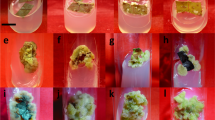Abstract
We evaluated the potential of chitosan both to stimulate plant development and to induce protection from Botrytis cinerea in Vitis vinifera L. plantlets. The presence of 1.75% (v/v) chitogel in the culture medium was the optimal concentration for in vitro grapevine plantlet growth, as determined by measurements on enhancement of root and shoot biomass. Photosynthesis and related parameters were also stimulated in chitogel-treated plantlets. Chitogel reduced the development of Botrytis cinerea and induced cytological alterations to the pathogen. When challenged with the fungus, a significant decrease in disease incidence was observed in plants growing on medium supplemented with chitogel. Furthermore, exogenous foliar applications of chitogel to plantlets growing on chitogel-free medium sensitized them so as to be protected against Botrytis cinerea attack. Our results indicate that chitogel can be used in the vineyard as a means to attain protection against Botrytis cinerea and that its application may counteract the wide use of chemical pesticides.





Similar content being viewed by others
References
Aharoni Y, Barkai-Golan R (1987) Pre-harvest fungicide sprays and polyvinyl wraps to control Botrytis rot and prolong the post-harvest storage life of strawberries. J Hortic Sci 62:177¯181
Benhamou N (1996) Elicitor-induced plant defence pathways. Trends Plant Sci 7:233–240
Benhamou N, Kloepper JW, Tuzun S (1998) Induction of resistance against Fusarium wilt of tomato by combination of chitosan with endophytic bacteria strain: ultrastructure and cytochemistry of the host response. Planta 204:153–168
Benhamou N, Bélanger R, Rey P, Tirilly Y (2001) Oligandrin, the elicitin-like protein produced by the mycoparasite Pythium oligandrum , induces systemic resistance to Fusarium crown and root rot in tomato plants. Plant Physiol Biochem 39:681–696
Bhaskara MVR, Arul J, Ait Barka E, Richard C, Angers P, Castaigne F (1998) Effect of chitosan on growth and toxin production by A. alternata f. sp. lycopersici. Biocontrol Sci Technol 8:33–43
Cote F, Hahn MG (1994) Oligosaccharin: structures and signal transduction. Plant Mol Biol 26:1379–1411
El Ghaouth A, Arul J, Asselin A, Benhamou N (1992a) Anti-fungal activity of chitosan on post-harvest pathogens: induction of morphological and cytological alterations in Rhizopus stolonifer. Mycol Res 96:769¯779
El Ghaouth A, Arul J, Grenier J, Asselin A (1992b) Antifungal activity of chitosan on two post-harvest pathogens of strawberry fruits. Phytopathology 82:398–402
El Ghaouth A, Arul J, Grenier J, Benhamou N, Asselin A, Belanger R (1994) Effect of chitosan on cucumber plants: suppression of Pythium aphinodermatum and induction of defense reactions. Phytopathology 84:313¯320
El Ghaouth A, Arul J, Wilson C, Benhamou N (1997) Biochemical and cytochemical aspects of the interaction of chitosan and Botrytis cinerea in bell pepper fruit. Postharvest Biol Technol 12:183–194
El-Ghaouth A, Smilanick JL, Wilson CL (2000) Enhancement of the performance of Candida saitoana by the addition of glycolchitosan for the control of postharvest decay of apple and citrus fruit. Postharvest Biol Technol 19:103–110
Elad Y (1994) Biological control of grape grey mould by Trichoderma harzianum. Crop Protec 13:35–38
Galzy R, Compan D (1992) Remarks on mixotrophic and autotrophic carbon nutrition of Vitis plantlets cultured in vitro. Plant Cell Tissue Organ Cult 31:239–244
Genty B, Briantais JM, Baker N (1989) The relationship between the quantum yield of photosynthetic electron transport and quenchers of chlorophyll fluorescence. Bioenergetics 990:87–92
Hadwiger LA (1994) Chitosan as crop growth regulator. In: Proc Asia-Pacific Chitin Chitosan Symp. University Kebangsaan Malaysia, Bang, Malaysia, pp 99–109
King EO, Ward MK, Raney DE (1954) Two simple media for the demonstration of pyocianin and fluorescein. J Lab Clin Med 44:301¯307
Krause G, Weis E (1984) Chlorophyll fluorescence as a tool in plant physiology. II. Interpretation of fluorescence signals. Photosynth Res 5:139–157
Martin C, Vernoy R, Carré M, Vesselle G, Collas A, Bougerey C (1987) The vine and techniques of in vitro cultivation. Bull Org Int Vigne 675–676:447–458
Owens T (1996) Processing of excitation energy by antenna pigments. In: Baker NR (ed) Photosynthesis and the environment. Kluwer, Dordrecht, pp 1–23
Saladin G, Magné C., Clément C (2003) Impact of flumioxazin herbicide on growth and carbohydrate physiology in Vitis vinifera L. Plant Cell Rep 21:821–827
Siedlecka A, Krupa Z (1996) Interaction between cadmium and iron and its effects on photosynthetic capacity of primary leaves of Phaseolus vulgaris. Plant Physiol Biochem 34:883–841
Acknowledgements
The present study was realized at Université de Reims Champagne-Ardenne, and was in part supported by Europol’Agro, Reims, France. The authors thank B. Gallois from Ecobulle Ltd (Cormontreuil, France) for providing the chitogel.
Author information
Authors and Affiliations
Corresponding author
Additional information
Communicated by S. Gleddie
Rights and permissions
About this article
Cite this article
Ait Barka, E., Eullaffroy, P., Clément, C. et al. Chitosan improves development, and protects Vitis vinifera L. against Botrytis cinerea . Plant Cell Rep 22, 608–614 (2004). https://doi.org/10.1007/s00299-003-0733-3
Received:
Revised:
Accepted:
Published:
Issue Date:
DOI: https://doi.org/10.1007/s00299-003-0733-3




